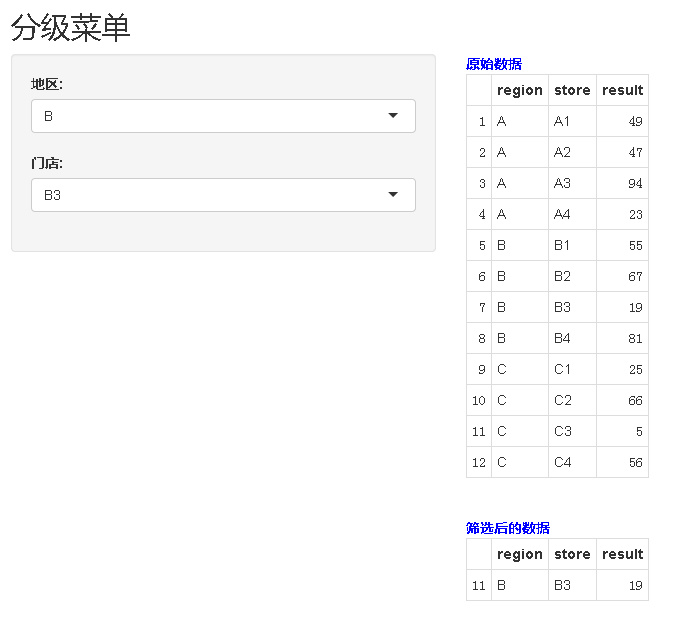R的shiny中的分级菜单
2017-06-06
选择地区A之后,再选择A地区的门店(下拉选项中只显示A地区门店) 参考了博文:http://blog.csdn.net/xwydq/article/details/51152988 http://shiny.rstudio.com/articles/dynamic-ui.html
效果图如下所示:

#######################
### level menu
### ui.R
######################
# utf-8
# http://blog.csdn.net/xwydq/article/details/51152988
library(shiny)
shinyUI(
fluidPage(
titlePanel(title = "分级菜单"),
sidebarLayout(
sidebarPanel(
selectInput("region", "地区:",
choices = region),
uiOutput("slt_store")
),
mainPanel(
div(strong("原始数据"), style = "color:blue"),
tableOutput("df1"),
br(),
div(strong("筛选后的数据"), style = "color:blue"),
tableOutput("df2")
)
)
))
#######################
### level menu
### server.R
######################
# utf-8
# http://blog.csdn.net/xwydq/article/details/51152988
library(shiny)
shinyServer(function(input, output, session) {
# data
df_sample <- data.frame(region=rep(LETTERS[1:3], 4),
store=paste(rep(LETTERS[1:3], 4), 1:4, sep=""),
result=sample(1:100, 12))
region <- unique(df_sample$region)
# 在server.R中使用renderUI
output$slt_store <- renderUI({
store_t <- sort(unique(subset(df_sample, region == input$region)$store))
selectInput("store", "门店:", choices = store_t, selected = store_t[1])
})
output$df1 <- renderTable({
arrange(df_sample, region, store)
})
output$df2 <- renderTable({
subset(df_sample, region == input$region & store == input$store)
})
})
## library(shiny)
## runApp("shiny_example/level_menu")备注:转移自新浪博客,截至2021年11月,原阅读数386,评论0个。